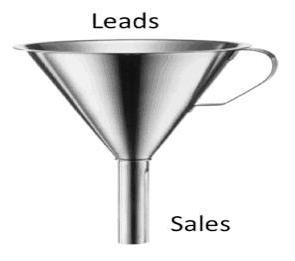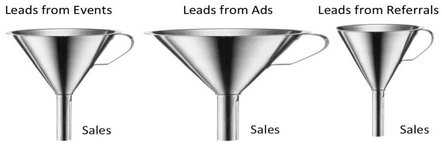Travel sales: where is it all leading?
EyeforTravel guest columnist takes a step-by-step look at how airlines can grow sales by paying more attention to where and when a booking originates
In business-to-business markets, the sales team manages a ‘sales funnel’. They maintain a list of prospects or ‘leads’, which are qualified over time, and to which various sales efforts are deployed to convert into ‘sales’.

In fractional jet sales, for example, we tracked the sales funnel by type of lead since the quality (likelihood of turning into a sale) was highly correlated with where it initially originated. Referrals from existing owners were among the best form of leads, while prospects generated from newspaper advertising were among the least productive. We developed ROI’s on alternative marketing initiatives based on the quantity and quality of leads generated. At the same time, we dramatically cut media and event advertising spent in favour of investing more in higher ROI website leads.

Airlines, on the other hand, have traditionally focused on ‘the booking’ - with less focus on ‘leads’ or ‘conversion rates’ - except in the context of their own B2B sales (a new corporation, for example). Most ‘bookings’ or sales appear out of nowhere, after the customer has researched a variety of sites, including OTA’s, destinations, social media and so on.
If you could develop a ‘sales funnel’ for your airline bookings, what would it look like? It should include:
1. Travel explorations by customer by destination and by date (‘leads’)
· Whois thinking about travelling? Are they exploring travel options to Las Vegas or Orlando or somewhere else? Are they focused on potential holiday travel or seeking an off-peak travel experience? Where do these potential travellers live?
2. Different conversion rates based on ‘seriousness’ of exploration (social media vs OTA’s, multiple sites accessed)
· Conversion rates are likely to vary from <1% (travel pipedreams) to almost 100% (a loyal frequent flyer investigating regularly-flown business flights for next week)
· The overall funnel is likely to be many times the booking volume itself, reflecting the high number of potential trips investigated
· There is likely to be a pattern in how trip investigations turn into bookings. For example, how many times does a frequent flyer access flights before booking? How long before the flight does investigation begin?
· There is even likely to be a pattern in how infrequent travellers explore flight options. How often do non-Customers look at your flights? Do many potential travellers investigate your flights and never book (at least on your airline)? What are the characteristics of these travel planners and the flights they are investigating?
3. Rich information for target marketing, deals, customised offers and so on.
· Airlines need to become ‘travel merchandisers’. Retailers strive to improve the sales conversion rate with offers of free shipping and two-for-one sales. With the relatively new ancillary fees now offered by airlines, we can now offer free bags or free inflight video to target customers to help turn a ‘lead’ into a ‘sale’.
· More personalised offers are possible with frequent flyers, including special fares and special mileage credits. Also, new offers can target potential passengers as a more sophisticated sales funnel is developed over time.
4. A multi-layered funnel that reflects conversion rates at each step in the customers’ travel planning process
· The travel planning process may take a few months or more for many travellers. Leads need to be tracked from the beginning, and then the response monitored for various interim marketing initiatives. After the initial contact, how many potential customers remain interested after the first follow-up or offer? Should offers be escalated over time? When is the perfect time to offer what kind of promotion?
· In addition to identifying the value of each kind of lead, the value of each targeted promotion can be assessed for improved targeting and overall market planning.
As airlines engage with their customers earlier in the booking process, there is an opportunity for the airlines to improve their merchandising by adopting and monitoring their ‘sales funnel’. Marketing needs to exploit the rich data now available to develop and refine targeted initiatives at various points in customers’ travel planning process.
This article has been produced exclusively by Tom Bacon, former airline executive and industry consultant in revenue optimisation. Questions? Contact Tom at tom.bacon@yahoo.com.

